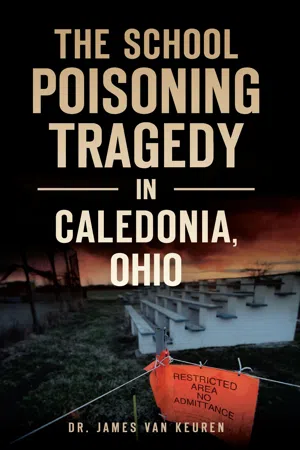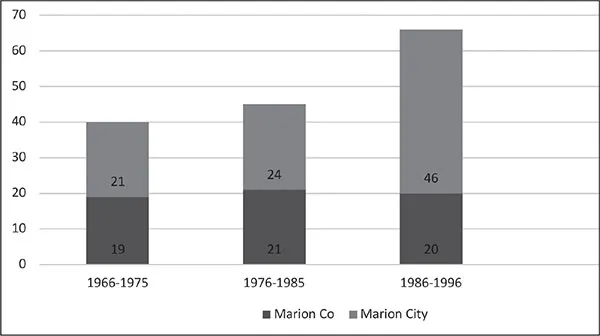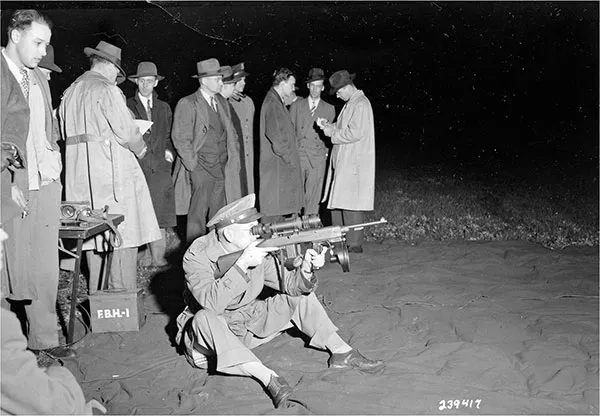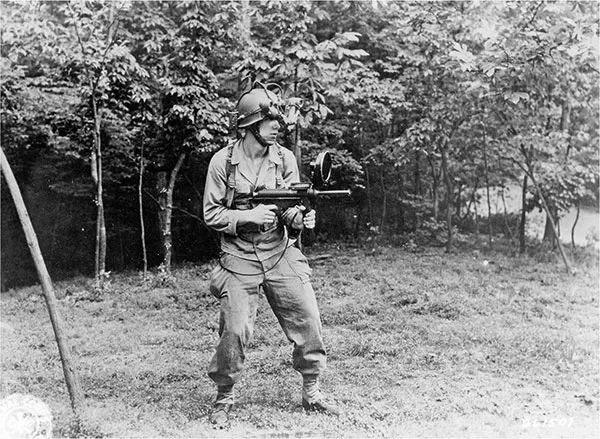![]()
1
BACKGROUND
Leukemia News Stuns Marion—Death Rates Up 122% in 30 Years, State Study Finds.
The River Valley Local School District built its middle school, high school and athletic fields on seventy-eight acres of the former Marion Engineer Depot in the early 1960s, but it was not until the late 1990s that residents of the district began to link the high rates of leukemia, non-Hodgkin’s lymphoma and other forms of cancer prevalent among the graduates to the possible activities of the former depot. The schools were built on the same area that was once used for heavy equipment and training, military artillery practice, materials storage, burial of construction debris and the burning of waste material and fuels. A radium-painted dime-sized aluminum disc was found just below the soil on the front lawn of the high school, a marker the army used to indicate the position of bridges and vehicles while troops were practicing nighttime operations. Other tests at the school site indicated the presence of volatile organic compounds in both the soil and perched groundwater on school property. Vats of chemical residues were buried in trenches covered with soil, over which the school built its athletic fields, unaware of the toxic danger. Once this hidden threat finally became known, it led to citizen outrage and concern for the health and welfare of the students.
Another grave concern was the discovery of arsenic in the drainage ditches along both sides of a former railroad spur where prisoners of war were dropped off during World War II upon their arrival at the Marion POW Camp. Apparently, it was here that the prisoners of war were sprayed with an arsenic-laden delousing agent upon exiting from railroad cars known to be treated with an arsenic-bearing fumigant still present at elevated levels fifty years later.
An article in the Columbus Dispatch of October 17, 1997, titled, “Leukemia News Stuns Marion—Death Rates Up 122% in 30 Years, State Study Finds,” tracked the growth in cancer rates among the local population. The accompanying chart, Tracking a Killer, put together by the state health department, compares the number of leukemia deaths in three ten-year periods for the city and county of Marion. A total of 151 deaths occurred among the city of Marion’s 34,075 residents and the county’s 94,274 residents (counted separately from the city) between 1966 and 1995. The article notes that the death rate from leukemia in Ohio over the same period was only 8 percent.5
This alarming comparison led to concern across the region and state, especially among the families of the students who had graduated and those still attending the River Valley Local School District. Proactive measures were undertaken by the Concerned River Valley Families group, which periodically ran ads—one of which was “River Valley Graduates and Families, We Need Your Help”—stating that more than seventy cancers had been reported to the group.6 The group’s members feared that there may be some unreported cases.
The removal of the chemicals and hazardous waste at the school district site has cost $5.7 million as of a July 31, 2001 report.7 In the end, approximately $8 million was spent on the school site cleanup and $35.7 million spent on the cleanup of the former Marion Engineer Depot grounds.8 The schools were finally closed and rebuilt in a different location in 2003 at a cost of $53.4 million, including a $8,071,192 (21 percent) match on the Ohio Facilities Construction Commission, $30.3 million (79 percent) passage of a local bond issue and a $15 million contribution from the U.S. Army Corps of Engineers for relocation purposes.9
Concerns over the contamination of the River Valley Local School District reached the Ohio statehouse, where Governor Robert A. Taft stated that “after at least six months of discussions officials concluded that building a new campus would be cheaper than cleaning up the site enough for schools to stay. The soils have been investigated; they are clearly contaminated and the school has already lost a significant part of its property for ballfields and play areas.”10 After Governor Taft got involved, the Ohio 123rd General Assembly followed and wrote in the Amended Substitute Bill 282 line item 200–580: River Valley School Environmental Issues for Fiscal Year 2000 (July 1, 1999–June 31, 2000) in the amount of $350,000, which “Shall be used to assist costs arising from environmental assessment and cleanup of potential environmental contamination of school facilities of the River Valley Local School District.”11 The environmental issues assessment, funded by the Ohio General Assembly, led to a section in Amended Substitute Senate Bill 272 for Fiscal Year 2001 (July 1, 2000–June 31, 2001) that authorized the Ohio School Facilities Commission to provide assistance under the Exceptional Needs Pilot Program allowing school districts not on the priority list to qualify through the new Extreme Environmental Contamination of Classroom Facilities program. This section provided for a complete districtwide project instead of merely replacing a contaminated facility and for using any federal restitution as a means of reducing the bonded indebtedness that it would take to complete the project.12
This legislation that allocated funds to examine school environmental issues for a particular school district, including the River Valley Local School District, and the creation of the Extreme Environmental Contamination of Classroom Facilities section in the school facilities program was certainly an acknowledgement by the Ohio General Assembly that there were environmental issues on the River Valley Local School District campus that may have been negatively affecting the health and welfare of the students. Today, the vacated school buildings are being used as private warehousing facilities, with the requirement that the sites are to be tested every five years for contamination based on the remediation that was done to those sites.
The cleanup of the former Marion Engineer Depot was done through the Formerly Used Defense Sites program under the categories of CON/HTRW (Containerized Hazardous Toxic and/or Radioactive Waste) and HTRW (Hazardous, Toxic and/or Radioactive Waste), programs that comport with a highly toxic area and the cleanup of radioactive waste matching the activities at the former depot and the seventy-eight acres purchased by the school district.13
OBSERVATIONS
The school district was placed on the Ohio Facilities Construction Commission priority list because of extreme environmental contamination at the middle school, high school and athletic field sites. This program, because of the River Valley Local School District environmental issues, set the stage for other Ohio school districts to use it as they sought to move from contaminated sites. The Extreme Environmental Contamination program became a model that could be imitated by other states when encountering contaminated school sites.
Under the Formerly Used Defense Sites program, the former Marion Engineer Depot was classified as a highly toxic site with a possible correlation of the toxicity to the school district sites, yet health officials were not able to determine whether the contaminated soil contributed to the various forms of cancer that afflicted the graduates.
In a May 31, 2017 article in the Columbus Dispatch titled “Questions Linger Decades after River Valley Cleanup,” reporter Dean Narciso encapsulated what many were feeling in the community after years of enduring the toxicity: “Today many of those who fought for more studies, accountability and justice feel that their happy high school memories have been dampened by what was buried under their playing fields.” One former student indicated that “years of cross country, track and cheerleading put her in almost daily contact with the often-soggy school grounds.” Another graduate contends that public pressure stopped further investigations that may have revealed the possible link between the contaminated school site to the high rates of cancer among former students.14
It is clear from hearing the voices in the community that the River Valley Local School District tragedy is an unfortunate legacy that will remain with the community for many years to come. Let us move forward with a detailed account of the contamination of the school district sites and lay out a disease and leukemia cluster to show how deeply affected the health of the graduates of the school district was by this contamination.
![]()
2
A TRAIL OF RADIOACTIVE MATERIALS
We were told from the time we got there that we will not find any radioactive contamination on the site anywhere. It wasn’t directed as an observation it was directed as an order.
On April 17, 1947, a radiation survey was done at the Marion Engineer Depot of several thousand stored metascopes, also known as sniper scopes, that were retrieved from various war zones. These metascopes were used as night vision devices and contained radioactive radium in the foil. Three different night vison devices may have been stored at the depot. The first night vision device attached to a rifle, the second attached to a submachine gun and the third to a handheld device.15
The workers in the storage area wore film badges to monitor the intensity of the radiation and to limit the amount of time they could be in the storage facilities. One notation in the survey indicated, “Work involving the carrying of cases into the building from outside or vice versa, should be limited to an hour. If it is necessary to station a man inside the building, this time should be limited to fifteen minutes.”16
Night vision device attached to a rifle. Courtesy of the NARA Photo: No. SC-239417, January 1, 1946.
Night vision device attached to a submachine gun. Courtesy of the NARA Photo: No. SC-261501, November 12, 1946.
Handheld night vision device. Courtesy of the NARA Photo: No. SC 464440, June 29, 1954.
The workers assigned to the buildings followed a tolerance level of 0.1 roentgens (unit of radiation exposure) per day or 0.7 roentgens per week. However, the limit of 0.7 roentgens per week could at times be received all in one day. A new guideline was developed that mandated that individuals should not stay inside longer than fifteen minutes. The results of the measures found that twenty-three* out of the twenty-six locations within the buildings exceeded the recommended tolerance level of 0.1 roentgens per day:
RESULT OF MEASUREMENTS
| T 308 Building | |
| | Gamma Radiation roentgens/8hrs. |
| Inside doorway entrance outer door | .048 |
| At the doorway along centerline of room, 4-foot-high cases on both sides | 0.3* |
| 4 feet inside | 0.98* |
| 8 feet inside | 0.75* |
| 12 feet inside | 1.4* |
| End wall | 1.6* |
| 5 feet high against surface of case which was stacked in storage | 0.5* |
| Against case surface 5.5-cubic-foot box | 0.75* |
| “ ” | 2.3* |
| T 509 Building | |
| At surface of lead box containing foils | 0.25* |
| At doorway entrance | 0.05* |
| 10 feet in from door along center of aisle, cases on left only | 0.17* |
| 20 fee... |




